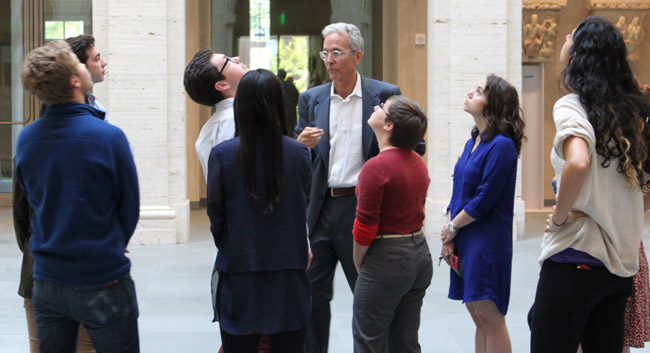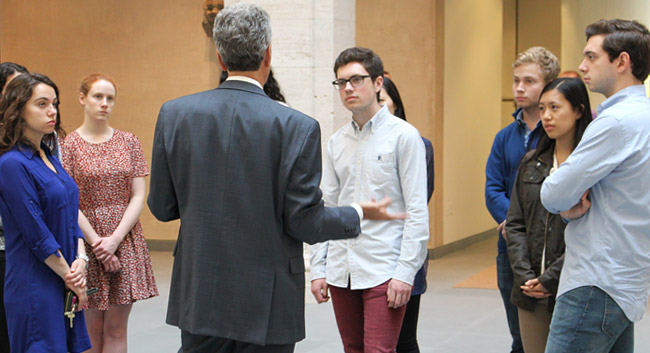Minutes after taking his first tour of the new Harvard Art Museums, student Dominic Ferrante ’15 was already excited to return. “When you step into the museums, you really feel like it’s an open and inclusive space,” he said. “It truly embodies the [#OpenThisFall] publicity campaign for the reopening. It’s definitely going to be a game changer on campus.”
Ferrante, a history and literature concentrator, is a member of the museums’ new Student Board, a diverse group of 19 students who serve as a powerful link between the museums and student life on campus. Along with other Student Board members, Ferrante last week received an advance tour from Thomas W. Lentz, the Elizabeth and John Moors Cabot Director of the Harvard Art Museums.
With the November opening still weeks away, Lentz focused his tour on the facility’s architectural highlights, including the reinvigorated Calderwood Courtyard and Renzo Piano’s “glass lantern,” or Light Machine. He emphasized the varied opportunities at the museums for interdisciplinary learning and close study as he led students throughout the building. A surprise stop was the Special Exhibitions Gallery, where students were given a glimpse of Mark Rothko’s Harvard Murals, the basis of the new museums’ inaugural special exhibition. The murals will be unveiled in November with an innovative digital projection technology that uses carefully calibrated light to approximate their original appearance.
As students peered into the glass-walled laboratories of the Straus Center for Conservation and Technical Studies, Lentz shared his hope that the space would facilitate greater understanding of museum work. Visitors will have a partial view of conservators as they restore paintings, sculptures, frames, and more. “We love the fact that we make this visible,” Lentz said. “We’re showing people what we actually do.”
Great care was taken to ensure that every aspect of the new museums would be as user-friendly and art-focused as possible, Lentz told students, right down to the gray paint on the walls of the Art Study Center. He encouraged students to view the galleries, Art Study Center, lecture halls, and other public spaces as “state-of-the-art classrooms”—and to use them often. “This new facility is essentially built for you,” Lentz said, adding that the very first opening event is for students.
The building’s careful restoration and expansion was not lost on Student Board members. “Everything is on a great human scale; it’s a space that really thinks about the people who are using it,” said Francesca Del Frate ’15, a molecular and cellular biology concentrator. She said she already feels like she’s a part of the museums. “There’s a sense of connection: between old and new, the building and the art. Everything is there for you.”



